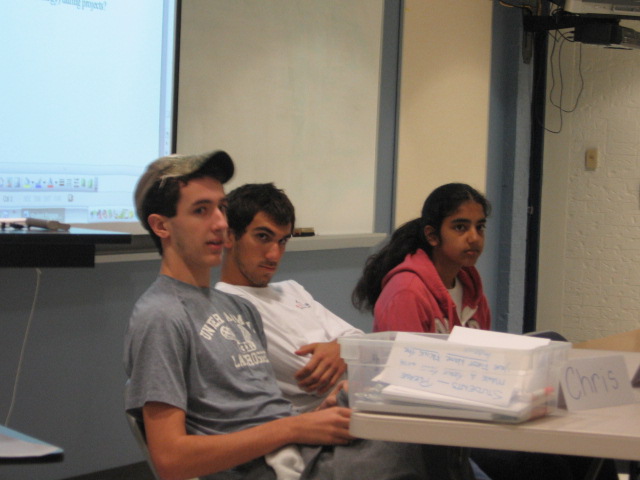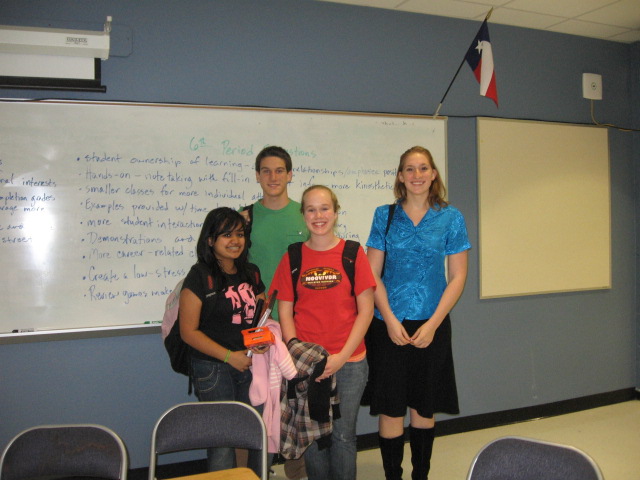Our campus staff development started its second strand last week–centered around the theme of authentic student engagement. (Our staff development period is built into the school day once each week).
 To begin the series, we on the staff development committee decided to invite panels of students to speak to our staff about how they learn best, their interests, and obstacles to learning. We met with students ahead of time and gave them a framework of questions to work from, like how they learn best, what are obstacles to learning, etc.
To begin the series, we on the staff development committee decided to invite panels of students to speak to our staff about how they learn best, their interests, and obstacles to learning. We met with students ahead of time and gave them a framework of questions to work from, like how they learn best, what are obstacles to learning, etc.
 Over two days, rotating panels of four students spoke to the faculty in small groups, with time for question and answer from teachers.
Over two days, rotating panels of four students spoke to the faculty in small groups, with time for question and answer from teachers.
It was a fascinating and engaging exchange–both for the teachers and the students. The panels had a consensus on some things–like preferring hands-on learning or participatory lectures or group work, while not on others (some thought they should have iPods in class, others didn’t.) Students overwhelming preferred to have quiet music playing in class–saying it helped them focus. As one student commented, silence is uncomfortable, so students start talking–the music helps “fill the void.”
They also had very specific advice about what makes group work better(smaller groups particularly–no more than 4 to a group and almost all of them preferred working in pairs).
The meaningfulness and length of homework was a big topic of conversation as well, with some students reporting as much as five hours a night of homework. One student pointed out that past two hours of homework, she really wasn’t learning because she was too tired. Others commented that they found it really valuable to have teacher websites where they could get help or download materials. All of them felt that homework was most valuable when it was meaningful and concise, and several mentioned finding online assignments very motivating.
We learned that students at our high school have study groups on Facebook for Spanish and Latin, among other things. We learned that they find powerpoint meaningless and overused–one student pointed out that ‘You can make a powerpoint without even knowing the topic.’ So they were interested in using a larger variety of media and in having choices in what projects they did. They liked the idea of choice and “feeling like they are in charge for a second.”
One student suggested that when projects tap into his own passions, they become much more meaningful for him.
 Students also liked teachers who shared their passions, and teachers who engaged them personally in some way. As one student pointed out, ‘When I know my teacher cares about me, it’s really hard to let them down.’ The power of relationship was a really significant part of the comments students made, and how significant that was to their learning.
Students also liked teachers who shared their passions, and teachers who engaged them personally in some way. As one student pointed out, ‘When I know my teacher cares about me, it’s really hard to let them down.’ The power of relationship was a really significant part of the comments students made, and how significant that was to their learning.
We’ve summarized the student responses in a Google Document .
This week in our staff development workshop, our tech coordinator, Joel Adkins, will be showing teachers websites that students use–particularly Facebook–so that we all have a better understanding of the tools that are important in their lives, and we’ll be discussing what the takeaways from the student panels were.
Joel is sharing part of an excellent powerpoint by Mary Madden (created for librarians, coincidentally ;)) about the Pew Internet Study and teen use of the internet.
So the question becomes, how can we incorporate what they are telling us (and showing us) into our teaching/libraries/labs/schools?
Congratulations! This is a great example of student voice. You focused on areas that the students really know and can provide relevant input on. So many times we tap into student voice about grandiose things that can’t actually be changed, like “how education should be different” and then wonder why their answers aren’t really useful.
You’ve again demonstrated how listening is the most important part of voice!
*hear, hear*
It was great that you listened to what students have to say. I think that’s the biggest change that has to happen for a 21st century school – and it can be accomplished with no technology. The most important change is that teachers (and administrators) must learn to regard themselves as co-learners with their students and listen to them. After all, the customer is king.
Congratulations!
What a meaningful and authentic approach to professional development! Sometimes teachers get so caught up in “best practice” and “new tools” that they forget what’s important – listening to the learner. And what a difference it can make in the classroom when all stakeholders feel that they’re represented!
I’ll be passing on your post to our admin team – hopefully this is something we can do here at ISB as well.